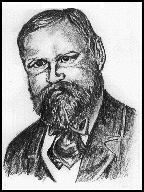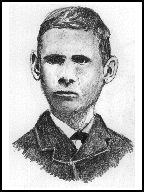
A.K. Erlang was the first person to study the problem of telephone networks. By studying a village telephone exchange he worked out a formula, now known as Erlang's formula, to calculate the fraction of callers attempting to call someone outside the village that must wait because all of the lines are in use. Although Erlang's model is a simple one, the mathematics underlying today's complex telephone networks is still based on his work.
He was born at Lønborg, in Jutland, Denmark. His father, Hans Nielsen Erlang, was the village schoolmaster and parish clerk. His mother was Magdalene Krarup from an ecclesiastical family and had a well known Danish mathematician, Thomas Fincke, amongst her ancestors. He had a brother, Frederik, who was two years older and two younger sisters, Marie and Ingeborg. Agner spent his early school days with them at his father's schoolhouse. Evenings were often spent reading a book with Frederik, who would read it in the conventional way and Agner would sit on the opposite side and read it upside down. At this time one of his favourite subjects was astronomy and he liked to write poems on astronomical subjects. When he had finished his elementary education at the school he was given further private tuition and succeeded in passing the Præliminæreksamen (an examination held at the University of Copenhagen) with distinction. He was then only 14 years old and had to be given special entrance permission.

Agner returned home where he remained for two years, teaching at his father's school for two years and continuing with his studies. He also learnt French and Latin during this period. By the time he was 16 his father wanted him to go to university but money was scarce. A distant family relation provided free accommodation for him while he prepared for his university entrance examinations at the Frederiksborg Grammar School. He won a scholarship to the University of Copenhagen and completed his studies there in 1901 as an MA with mathematics as the main subject and astronomy, physics and chemistry as secondary subjects.
Over the next 7 years he taught in various schools. Even though his natural inclination was toward scientific research, he proved to have excellent teaching qualities. He was not highly sociable, he preferred to be an observer, and had a concise style of speech. His friends nicknamed him "The Private Person". He used his summer holidays to travel abroad to France, Sweden, Germany and Great Britain, visiting art galleries and libraries. While teaching, he kept up his studies in mathematics and natural sciences. He was a member of the Danish Mathematicians' Association through which he made contact with other mathematicians including members of the Copenhagen Telephone Company. He went to work for this company in 1908 as scientific collaborator and later as head of its laboratory.
Erlang at once started to work on applying the theory of probabilities to problems of telephone traffic and in 1909 published his first work on it "The Theory of Probabilities and Telephone Conversations"[1] proving that telephone calls distributed at random follow Poisson's law of distribution. At the beginning he had no laboratory staff to help him, so he had to carry out all the measurements of stray currents. He was often to be seen in the streets of Copenhagen, accompanied by a workman carrying a ladder, which was used to climb down into manholes. Further publications followed, the most important work was published in 1917 "Solution of some Problems in the Theory of Probabilities of Significance in Automatic Telephone Exchanges"[2]. This paper contained formulae for loss and waiting time, which are now well known in the theory of telephone traffic. A comprehensive survey of his works is given in "The life and works of A.K. Erlang"[3].
Because of the growing interest in his work several of his papers were translated into English, French and German. He wrote up his work in a very brief style, sometimes omitting the proofs, which made the work difficult for non-specialists in this field to understand. It is known that a researcher from the Bell Telephone Laboratories in the USA learnt Danish in order to be able to read Erlang's papers in the original language.
His work on the theory of telephone traffic won him international recognition. His formula for the probability of loss was accepted by the British Post Office as the basis for calculating circuit facilities. He was an associate of the British Institution of Electrical Engineers.
Erlang devoted all his time and energy to his work and studies. He never married and often worked late into the night. He collected a large library of books mainly on mathematics, astronomy and physics, but he was also interested in history, philosophy and poetry. Friends found him to be a good and generous source of information on many topics. He was known to be a charitable man, needy people often came to him at the laboratory for help, which he would usually give them in an unobtrusive way. Erlang worked for the Copenhagen Telephone Company for almost 20 years, and never having had time off for illness, went into hospital for an abdominal operation in January 1929. He died some days later on Sunday, 3rd February 1929.
Interest in his work continued after his death and by 1944 "Erlang" was used in Scandinavian countries to denote the unit of telephone traffic. International recognition followed at the end of World War II[4].
References
[1] "The Theory of Probabilities and Telephone Conversations", Nyt Tidsskrift for Matematik B, vol 20, 1909.
[2] "Solution of some Problems in the Theory of Probabilities of Significance in Automatic Telephone Exchanges", Elektrotkeknikeren, vol 13, 1917.
[3] "The life and works of A.K. Erlang", E. Brockmeyer, H.L. Halstrom and Arns Jensen, Copenhagen: The Copenhagen Telephone Company, 1948.
[4] Proceedings of the C.C.I.F. ("Le comité consultatif international des communications téléphoniques à grande distance"), Montreux, 1946.